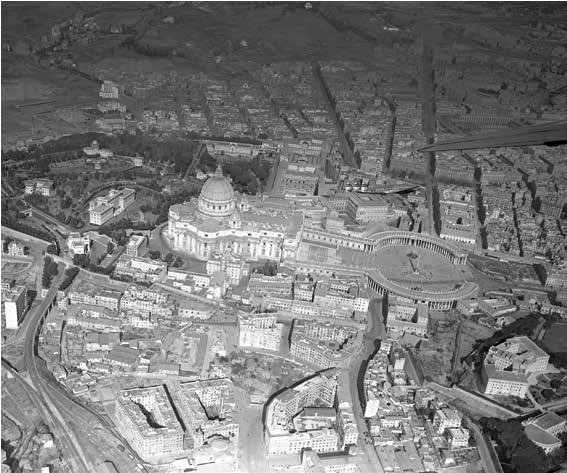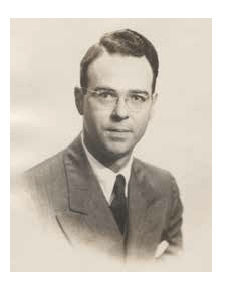Issue:
In 1945, the U.S. tried using the Vatican as a route for peace feelers to Japan. But the destination of the cables outlining the offer remains a mystery.

On May 27 last year, following the G7 Summit at Ise Shima, Barack Obama became the first sitting U.S. president to visit Hiroshima. Accompanied by Prime Minister Shinzo Abe, Obama laid a floral wreath at the cenotaph for the atomic bomb victims and, in the speech that followed, expressed his wish to pursue a world without nuclear weapons.
Obama’s historic visit received worldwide coverage by the media, including many FCCJ members. In his address, he noted: “Seventy one years ago, on a bright, cloudless morning, death fell from the sky and the world was changed. A flash of light and a wall of fire destroyed a city and demonstrated that mankind possessed the means to destroy itself.”
by EIICHIRO TOKUMOTO
Many people feel that raising the hypothetical question “what if?” is a useless exercise. And while it’s true that such hypotheses cannot be proved, it’s hard to resist asking questions such as this one: “If Japan had somehow agreed to end the war sooner even by just a month could the tragedies of Hiroshima and Nagasaki have been avoided?”
For Martin Quigley, a U.S. agent for the forerunner of the CIA during WWII, the question was not simply an academic exercise, but one with an answer that he might have affected if things had gone differently. The following story is one he kept secret, even from his own family, for many years.
Martin S. Quigley was born in Chicago in November 1917. Following graduation from Georgetown University, he went to work as a reporter for Motion Picture Daily. But when war broke out, he volunteered for and was accepted by the newly established Office of Strategic Services.
Quigley underwent training as a field operative, receiving instruction in communications through cyphers and training in firearms, demolition and other accouterments of the spy trade. He was then posted to Ireland in 1943 where, under cover as a representative of the Motion Picture Producers and Distributors of America, he collected political and military intelligence.
After a brief return to the U.S., Quigley was assigned to Rome under the same cover in December 1944. The operation was under the direct orders of OSS director Maj. Gen. William J. “Wild Bill” Donovan.
“I met Donovan at his office at OSS headquarters,” Quigley told me in an interview at his home in Hartford, Connecticut, in May 2009, “and the conversation was very brief. He said, ‘Martin, I want you to be alert to the opening of communication with Japan, looking to their surrender, using your Vatican contacts.’”
That the OSS spymaster himself would send Quigley on such a delicate mission to make contacts with Japan points to its political importance. But both Donovan and Quigley were practicing Roman Catholics and their religious backgrounds were instrumental in helping them gain access to intelligence from church sources, not only in Rome and parts of German occupied Europe, but from Asia as well.
Speaking of his former boss, Quigley told me, “Donovan was soft spoken, old fashioned and a man of great vision. He was eager to undertake any scheme he thought had some chance to help end the war.”
SO ONE AFTERNOON IN May 1945, soon after Germany’s surrender, Quigley invited Italian priest and Vatican diplomat Monsignor Egidio Vagnozzi to his Rome apartment. After raising a celebratory toast of beer to the German surrender, Quigley disclosed his true role as an undercover agent of OSS and solicited Vagnozzi’s assistance.
He asked Vagnozzi to be the contact in an attempt to open up communications with Tokyo regarding a possible surrender scenario. Should there be interest on the part of the Japanese government, he told the priest, top level negotiators could be available on short notice for secret meetings in or near Rome.
Quigley’s approach was not an easy one. “I had to not only disclose my actual role of OSS agent but also had to seek cooperation,” he said. “I knew it would be difficult because it was generally known that Pope [Pius XII] had given orders to all his people not to get involved with exactly what I was assigned. This was outside his personal charge. But I was able to convince Vagnozzi that as a priest he had higher responsibility.”
Vagnozzi moved quickly. He contacted a Japanese priest who was an adviser to the Japanese mission and Quigley’s message was conveyed to Ken Harada, the diplomatic envoy. This ignited a furious debate at the mission over whether or not Tokyo should be notified, since there were concerns, of course, that the approach might be viewed as a plot by enemy spies.
In any event, Harada sent a cable at the beginning of June outlining Quigley’s proposal to the Ministry of Foreign Affairs. After several days with no response from Tokyo, the envoy, through Vagnozzi, asked the American to provide detailed terms of surrender. A somewhat bewildered Quigley, on his own initiative, replied that the terms would include preserving the emperor system and other points.
But the lines from Tokyo remained silent. The next month, on July 26, the Potsdam Declaration was issued, and within the next two weeks, atomic bombs were dropped on Hiroshima and Nagasaki, leading Japan to declare unconditional surrender on Aug. 15. In the end, the OSS Vatican initiative had come to naught.
When I showed curiosity about the results of his offer, Quigley told me, “If I were in your position, I would concentrate on finding out why the Japanese Foreign Office didn’t respond to Harada’s cables. I was later told that it was very unusual that the two cables were not acknowledged. They didn’t even let Harada know the cables were received. Why?”
I ASKED HIM THEN what he thought would happen if the feelers via the Vatican had made their way through channels. “The bombs would not have been dropped in Hiroshima and Nagasaki,” he replied. “More importantly, had we not dropped the bombs, other major powers would have no incentive to try to develop them. I think the idea of an atomic bomb free world could have been a real possibility.” He expressed similar thoughts in a memoir of his time at the Vatican titled Peace Without Hiroshima, published in 1991.
So I went in search of the cables’ destination, and found copies in the Diplomatic Archives of the Foreign Ministry. The first, received on June 5, 1945 was recorded as “Top Secret cable No. 53.” The second, received June 14, marked cable No. 59, totaled 10 pages of text and contained proposals from “an American in Rome.” There were the seals of Foreign Minister Shigenori Togo, a vice minister and a director on the two cables, indicating they had been read by top level Foreign Ministry officials. What happened after that is a mystery.
The web site of Japan’s Diplomatic Archives describes the Vatican operation of the OSS as having been conducted by “a person of unknown identity and purpose,” and indicates that Japan replied negatively to the proposal to open negotiations, and that the OSS approach did not lead to any concrete negotiations. This is clearly at odds with Quigley’s account that no reply was received.
Nor is this account the only dubious matter. A book published by a private publisher in the 1970s titled The Diplomacy of Japan, produced under the editorial direction of former senior Foreign Ministry officials, includes what is claimed to be the full text of the two cables from Harada. However, it appears that portions of the documents had been deliberately altered. For example, references to the surrender terms that Quigley had relayed had been deleted from the text that appeared in the book.
Surprisingly, the person who had requested the revisions was Harada, the former Japanese envoy to the Vatican. The book’s editing had been supervised, in fact, by the former vice foreign minister and the director who had both seen Harada’s cables from Rome.

Martin S. Quigley of the OSS, pictured at the end of WWII – he was asked to contact the Vatican (opposite in 1946) with an aim of negotiating Japan’s surrender
IT TURNS OUT THAT Quigley had also attempted to find out what happened. In February, 1972 he sent a letter to Harada, in which he revealed his role in Rome as an OSS operative, writing: “I think that you and I have an obligation to history but an even greater obligation to the future. . . . the ends of historical research and future needs would be well served if some light could be shed on what happened to your message or messages in Tokyo. Why was there no response? Was the explanation that word never reached the persons who could act on the possibility of secret peace making talks in Rome? Or did the word reach high authority that made the decision not to respond favorably?”
Harada replied to Quigley that, at the time, Tokyo had already decided to seek peace via the Soviet Union and that it was quite impossible to alter that policy. Then he added, “What is more significant for me in looking back from now is that before the outbreak of war, His Majesty the Emperor had ordered the Government to open diplomatic relations with the Vatican and to dispatch an envoy there in order to be ready for peace negotiations in case of war which he was most anxious to prevent. . . . So much so I personally feel very sorry that I remained quite unserviceable to attain the original desire of His Majesty although I was there at the Vatican as His Special Envoy.”
Surprising as it sounds, it’s true that even before the war had commenced, Emperor Hirohito had apparently considered going through the Holy See to negotiate its end. This was borne out in the posthumously published Showa Tenno Dokuhaku Roku (The Showa Emperor’s Monologue), which high lighted his awareness of the Holy See’s spiritual influence around the world. He believed that the Vatican could be useful, both as a source of information and for helping to bring the war to a conclusion, and in 1942, not long after Pearl Harbor, Japan established diplomatic relations with the Vatican.
Knowing this, it’s entirely possible that Harada was moved to alter the text of the book out of feelings of guilt over his failure to comply with the Emperor’s wishes.
Of course, in the end the Soviet Union declared war on Japan, nullifying the Japan Soviet Neutrality Treaty. It can never be known whether the peace feelers via the Vatican could have ended the war sooner and prevented the use of atomic bombs on Hiroshima and Nagasaki.
In his letter to Harada, Quigley wrote, “I think we should rest easy in the confidence that each of us did the best we could in the light of prevailing circumstances. I think it is a mistake to look at the past through ‘what might have been’ concerns. However, I believe that it is most important that everyone, especially policy makers in governments, learn from the past.”
On Feb. 5, 2011 Martin Quigley passed away in Hartford, Connecticut at the age of 93. According to a family member at his bedside, his final words were, “Thank God for all the wonders.”
Eiichiro Tokumoto, a former Reuters correspondent, is an author and investigative journalist.

